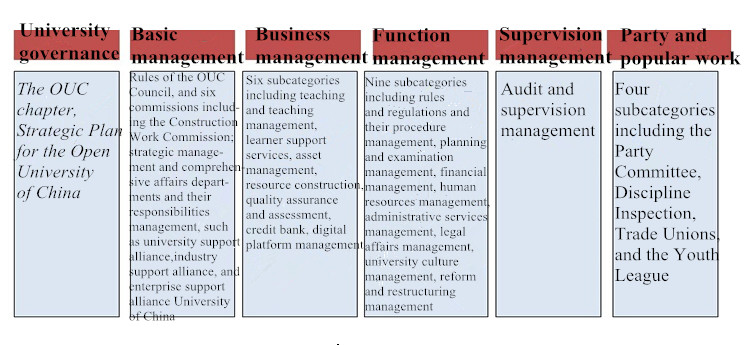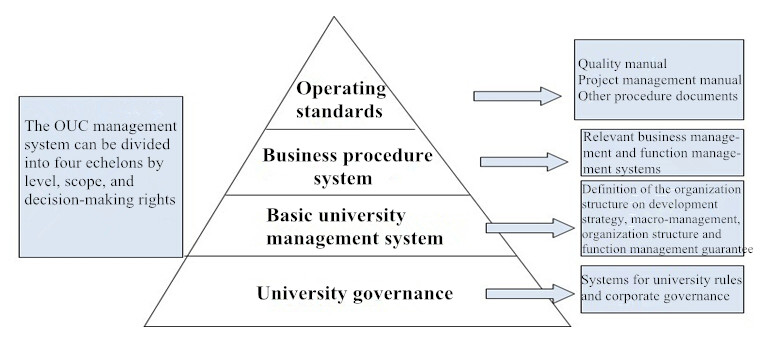Page 3 of 5
2.1 Integrity and coordinationThe OUC, as a nationwide educational organization system, should define the content of system construction from the perspective of the whole development process. It should serve as a powerful measure to ensure the routine performance of each department or unit with no blind spots. All aspects of the system must be coordinated, linked by scientific standards, distinctive features and a suitable structure. Integrity and coordination conform to the underlying demand for “legality” in a modern university system with Chinese characteristics.
2.2 Long-term validity and stability
The OUC system must be stable during a fixed period of time in order to ensure the long-term survival of its spiritual core. As a result, any process of establishment or abolishment must follow certain administrative procedures. This matches the “universality” of a modern university system with Chinese characteristics, which aims to maximize the preservation and heritage of the western university spirit developed over a long history and recognized by the international community.
2.3 Creativity and Self-improvement
As a complex dynamic self-organization system, the OUC is able to adapt to the changing requirements of both its internal and external environments. The construction of its system should be creative and self-improving, with constantly updated teaching and management concepts, the timely use of reference materials, and the proper application of relevant experience from at home and abroad. It is necessary to make a systematic summary of the gains and loses of the China Central Radio and TV University (CCRTVU)’s institutional design and undergo constant self-improvement and institutional innovation motivated by the situations and problems arising during the OUC construction. Innovation and self-improvement reflect the characteristics of “modernity” and “efficiency” of a modern university system with Chinese characteristics.
2.4 Richness and gradualism
This is a necessary requirement for the aforementioned features. It is also determined by the difficult task of the OUC construction and the complexity of the OUC system. It is not only necessary to solve the many persistent issues that arise during the construction of the system, but it is also necessary to reform and innovate the OUC management system and operating mechanism, so as to meet the needs of the system at different levels. The realization and manifestation of this must be a rich and gradual process that complies with the OUC’s development objectives, education scale and present situation. This is in accordance with the “diversity” of a modern university system with Chinese characteristics.
Ⅲ. The main content and framework of the construction of the OUC institutional system
1. Main content of the construction of the OUC institutional system
The institutional system can generally be divided into three basic levels: fundamental system, basic system, and specific rules and regulations according to nature and scope. The fundamental system provides the guidelines and basic activity provisions appropriate to a certain period of the university’s development, such as the OUC chapter. The basic system refers to the specific organizational structure of the university, such as schools, teaching affairs management, learner support, and supervision and assessment. Specific rules and regulations are behavior patterns and work procedures made by various cooperative organizations and departments, such as systems on examination and degree management. Based on its horizontal and vertical structure, the system can be divided into a “content management system” and a “control management system”. The former refers to sorting business-specific content modules, while the latter mainly deals with management procedures. By concentrating on the contents of the OUC system, referring to system classification of nature, scope and contents, and combining the features of the OUC system, as shown in figure 2, the horizontal structure covers university governance, basic management, business management, function management, supervision, and Party and popular work. As shown in figure 3, the vertical structure includes the systems of university governance, basic university management, business procedures, and operating standards.

Figure 2 The Horizontal Structure of the OUC Institutional System

Figure 3 The Vertical Structure of the OUC Institutional System
The strategies and objectives of the OUC can be leveraged effectively during daily teaching and management by working from the perspective of the different departments and relationships within the OUC management. Every task is governed by systematic, standardized procedures and supervision. Every strategic decision can be broken up into solid development measures that improve the unrefined, vague nature of traditional management. All this will improve efficiency, reduce management costs, strengthen cohesion and enhance the the OUC’s core competitiveness, establishing its unique “brand” for open learning.